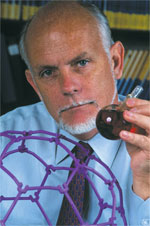Open source science


In open source science the entire campus can share in the discovery process. It doesn't matter what your discipline is, you can find a role to play. And when folks with different disciplines get together, breakthroughs can occur.
The man I consider the father of this open source science, Dr. Richard Smalley, died last week at age 62.
Dr. Smalley is probably best known for his 1996 Nobel Prize, won with Dr. Robert Curl and Dr. Harry Kroto for their discovery of Buckyballs, a form of carbon with 60 atoms arranged like a soccer ball. It was named for R. Buckminster Fuller, who spoke at Rice when I was an undergraduate there, some time before Smalley joined the faculty in 1976.
But I believe Smalley's biggest accomplishment is the Center for Nanoscale Technology and Science. Look at the wide-ranging disciplines of the faculty members. That's not just for show. The CNST has had several breakthroughs in recent years I attribute to just this structure.
Dr. Naomi Halas, an electrical engineer, has become a pioneer in gold nanoshells, which apply the basic structure of the Buckyball to a conductor. Bioengineers Jennifer West and Rebekah Drezek are applying gold nanoshells to cancer treatment. Chemist Jim Tour has developed the world's smallest car.
The point is by breaking down walls between disciplines, an open source method applied to science, amazing things can happen. Suddenly you have a lot of minds coming at problems from a lot of directions. It works. And it's going to transform science just as open source has transformed computing. Just as Dr. Smalley transformed my old school.